The UK’s peatlands are home to some of our rarest plant species, some of which exhibit specialised adaptations to the unique conditions of their habitats. These species have highly restricted ranges, often as a result of human activities that have resulted in habitat losses. Many of these species occur in smaller niche mire habitat types, which are often sidelined in general discussions, policy contexts and restoration efforts. Therefore, we will also use this showcase as introduction to the UK’s fascinating upland fens, particularly alkaline fen in order to raise greater awareness.
Many people will be familiar with the extensive areas of blanket bog peatlands which cover many of the UK’s upland areas. Fens, however, are more commonly considered in the context of lowland areas, where they are highly threatened by intensive agriculture. Less familiar are fen habitats found in the uplands, which tend to be smaller in size and diffuse in their distribution, localised to where springs, seepages, flushes and rills create areas of enrichment.
We will examine in greater detail the importance of these oft-overlooked upland alkaline fen and associated habitats, which although small are nonetheless an important part of the upland habitat mosaic. These alkaline fens represent some of the UK’s only remaining natural habitats – those which have not be altered by human activity. They may act as vital refugia for some of the rare species highlighted here, which whilst not all exclusively mire species have found strongholds in some of these habitats where they are subject to less pressure than in other parts of their range. These beautiful microsites often have abrupt boundaries which demarcate them from the surrounding habitats. This is due to the mineral rich waters that rise through them.
The keen-eyed will likely note marked colour changes within the landscape resulting from the distinctive plant communities that contrast sharply with the surrounding vegetation. In some situations, the mineral-enriched water can also mix the acidic water from around creating conditions for another group of species with very narrow niches, including the highly protected varnished hook-moss Hamatocaulis vernicosus. The integrity, and restoration, of these chemical and hydrological gradients in mires is of fundamental importance in restoring not only the full range of mire biodiversity but also - and perhaps more critically - the function and resilience of the whole peatland ecosystem.
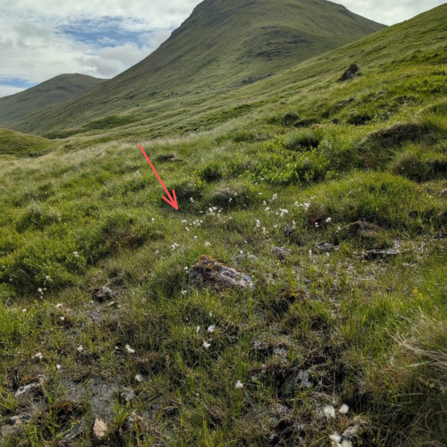
Transition areas can be difficult to spot amongst dense vegetation. Here the red arrow highlights what to look for, in this case a marked transition from Myrica gale to Eriophorum latifolium and Carex sp. dominated flush. The presence of Eriophorum latifolium is indicative of a high (alkaline) pH. Credit: Jess Fìor-Berry.
What are upland alkaline fens and why do they matter?
Upland alkaline fens, (which may result from flushing or seepage) include a number of different sub-habitats some of which are rare, while many are geographically scattered habitats across the UK. While they most often occur as inclusions into larger habitat types, hydrologically they can make a significant contribution to the wider mosaic. They often occur within heath or grassland habitats but also within bogs where nutrient rich waters create favourable conditions.

The occurrence of species such as Sphagnum platyphyllum (indicated by the arrow) and Warnstofia sarmentosa within an acidic mire complex such as this one in Sedbergh, Cumbria indicates base enrichment, as these species favour alkaline habitats. Credit: Iain Diack.
They are categorised as UK biodiversity action plan (BAP) priority habitats (as upland fens, flushes and swamps). While they can vary in size, they are often very small sites, being highly restricted by the need for a continual flow of base-rich groundwater over or through the surface layers, and the spatial extent over which this diffuse flow can occur. They may occur across upland areas wherever the hydrology creates suitable conditions.
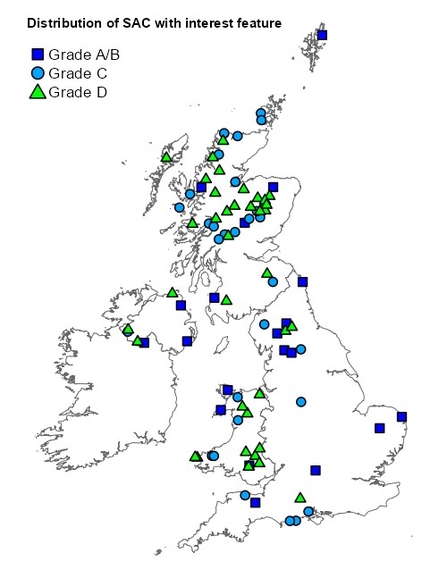
a. Distribution of SAC designated calcium rich fens within the UK, grade A are classed as outstanding examples of the habitat at European level, down to D which are classed as examples below SSSI quality (note that this map covers all calcium rich fens in the UK including lowland and upland). Credit: JNCC.
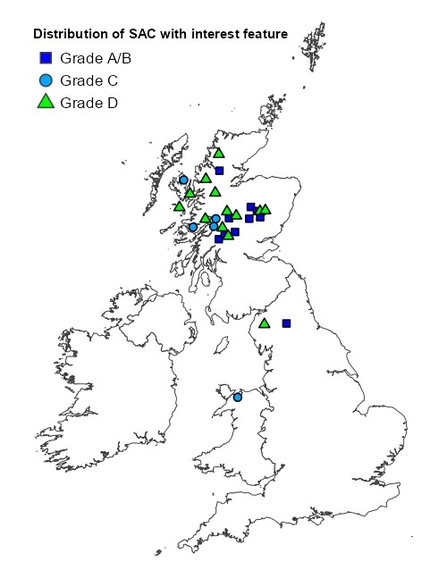
b. Distribution of designated alpine pioneer formation type mires which include the M10, M11 NVC mires where a number of the species we cover in this showcase are found, showing the limited range of the habitat. Credit: JNCC.
The peat deposits on these habitats may be thin, or even absent, and for this reason they are of particular interest when discussing the idea of what a peatland is, especially where depth- based, or organic content definitions are used. Although tiny, these habitats are important as they are often the sources of our streams and rivers. Springs rise where the underlying rock is impermeable, and where it remains impermeable downslope, water will diffuse out across the surface leading to flushed areas which are able to support high species diversity.
Percolation spring and seepage habitat with extensive patches of Palustriella sp. Credit: Richard Lindsay.
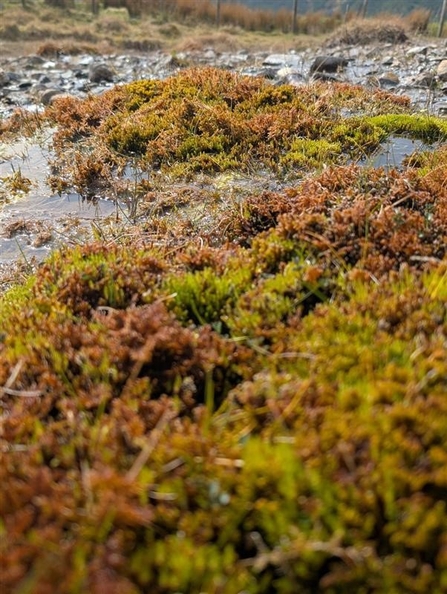
Close-up of bryophyte community (Palustriella and Bryum sp.). Credit: Jess Fìor-Berry.
One of the other identifying features of some of these habitats is the tufa formation that can form as a result of the calcium carbonate deposits from the upwelling water onto the surface. These deposits may initially be soft and spongy and highly sensitive to disturbance; left over time however, they will harden into the sedimentary rock that is known as travertine. Hook beak tufa moss is a characteristic moss (Hymenostylium recurvirostrum) of the habitat. The mosses may eventually be overwhelmed by the tufa deposition, but they may also grow on top of the tufa deposition, and there is likely to be some seasonal ebb and flow coincident with growing and deposition cycles. Tufa forming springs themselves are not considered peatlands, but they may occur within fen peatland sites, illustrating the complexities of peatland mosaics.
The flushing that is associated with these habitats can support high species diversity in what are often otherwise marginal (i.e. highly stressed) habitats. In montane regions particularly, where nutrients may be less readily available and soils more frequently acidic, the mineral enriched fen systems support a host of rare vascular plants and bryophytes. They may act as refugia for species which would otherwise be unable to gain a foothold in the broader habitat. The waterlogged and nutrient-poor conditions can also lead to specialist adaptations such as insectivory seen in plants like Pinguicula vulgaris (common butterwort) or parasitism such as that of Pedicularis palustris (Marsh lousewort).
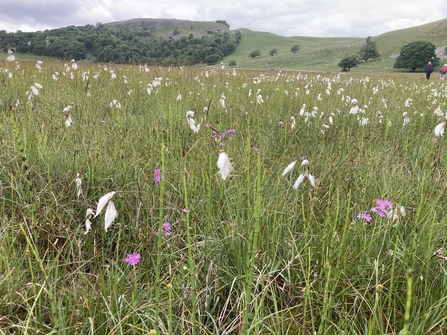
Ha Mire, Malham, North Yorkshire with Primula farinosa and Eriphorum angustifolium. Credit: Iain Diack.
Threats to upland alkaline fen habitats
Upland alkaline fen habitats with their localised occurrence and generally small extents mean that they are highly vulnerable to perturbation, which is thought to have resulted in widescale loss of the habitat, although the exact extent is unknown. Drainage, trampling and overgrazing are among the most significant threats to these small habitats. Conversely, under grazing can be problematic in allowing overgrowth. Enrichment from the atmospheric deposition of nitrogen, livestock manure and fertiliser can also allow more competitive species to establish and overgrow.
Where poor planning (for example bisection by tracks or roads) does not consider the importance of these habitats to the hydrological function of the downslope mosaics it is possible to find areas which have been cut off from the supply. Over time a shift in the habitat type is likely to occur due to drying and also loss of the base enrichment. It also demonstrates the importance of considering these ecotones to the broader habitat function as was highlighted in the recently published report [Definition of Favourable Conservation Status for Blanket bog - RP2967] which included these transition habitats. ‘Planning’ should also be contextualised as restoration planning here, it is important to avoid these areas of water collection being used as outflows from restoration projects without consideration of the possible impacts on these delicate ecosystems. While evidence around restoration of these boundary and transitional habitats is limited, what we do know suggests that greater consideration should be given to their inclusion in restoration projects and research could support how best to meet this objective.
Scottish asphodel (Tofieldia pusilla)
NVC habitat types: M10, M11
Scottish asphodel is a small herbaceous plant which, like the more common bog asphodel (Narthecium ossifragum) is sometimes grouped with the lily family, although it is now classified within its own family Tofieldiaceae. The plant was first identified as a new species to science by the botanist and natural historian John Ray, who discovered the plant close to the Scottish border close to Berwick on Tweed. The species was subsequently named after the 18th Century Yorkshire botanist Thomas Tofield, the pusilla part of the name is derived from the Latin for ‘very small’. In Scottish folklore it was known as ‘Kings knot’ and was believed to have magical properties that could ward off evil.
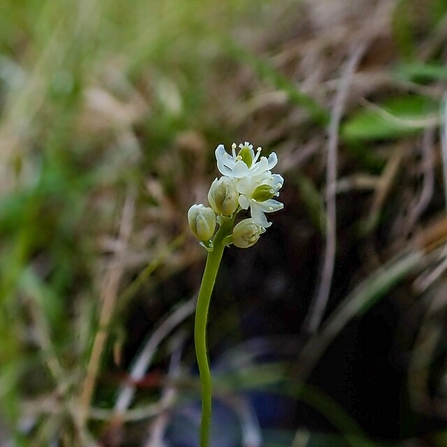
Tofieldia pusilla in close-up. Credit: Sam Thomas via iNaturalist.
As its scientific name implies, Scottish asphodel is a diminutive plant, the flower spike measuring between 5-15 mm. With its pale flowers it may be easily missed amongst the sedges with which it is typically found. The characteristically smooth, hairless, relatively fleshy leaves are flattened and are arranged in a distinctive fan formation that makes it easily distinguishable from sedges. Bog asphodel has similar flattened leaves and the characteristic fan arrangement. However, the leaves of bog asphodel are much longer, and unlike those of Scottish asphodel they are not evergreen, turning a distinctive orange before dying back in autumn. Although the habitats of the two species do not generally overlap, in some areas they occur in close proximity and therefore the leaves are a useful identifier.
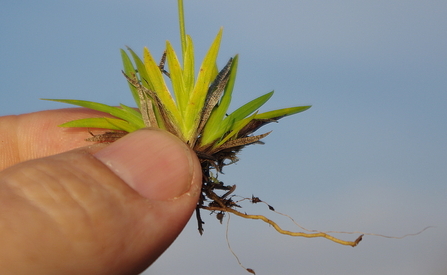
Tofieldia pusilla showing the fan shaped leaves. Credit: Georgy Vinogradov via iNaturalist.
Although the plant is thought to be relatively stable across its core range, declines have been recorded on the fringes of its habitat. The common threat of nitrogen deposition may be amplified at habitat margins where other plants are already present and able to readily establish when condition become suitable.
Bird’s eye primrose (Primula farinosa)
NVC habitat types: M10, M11
Bird’s eye primrose is a beautiful, but delicate plant which grows between 3-20 cm in height. The species preferentially occurs on hummocky and bare wet areas of calcareous flush and fen where the open sward allows it to thrive. When in flower it has a striking spray of pink flowers with a bright yellow centre that gives rise to the ‘bird’s eye’ moniker. The renowned alpine botanist Reginald Farrer, who came from Ingleborough, called Bird’s eye primrose, “my best friend among English wildflowers”. In a vegetative state its leaves may be missed among taller plants. Leaves are typical in appearance to other members of the Primula family with a crinkled appearance; they are small and spoon-shaped, in a basal rosette arrangement. The species takes its name from the Latin ‘farina’ meaning flour, as the flower stalks have a mealy appearance as if coated in flour.
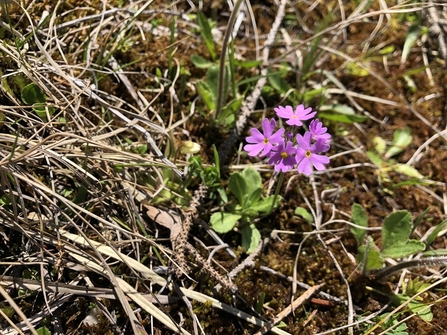
Primula farinosa in-situ showing its relatively small size amongst sedges. Credit: Jason Grant via iNaturalist.
It was first described in the UK from the limestone areas of Lancashire and Yorkshire. The species is distributed within a relatively narrow band across the north of England, from Cumbria across to Northumberland. Overall, the species has declined from its original extent and there have been no records of the plant occurring in the UK outside England since 1925 when it was last recorded in Scotland. The decline is largely attributable to grazing, drainage and from both direct application of fertilisers and diffuse nutrient enrichment, which may be water and air borne. These pressures have allowed other, hardier species to outcompete it, and in areas where it does survive heavy grazing pressure often means that it does not successfully flower.
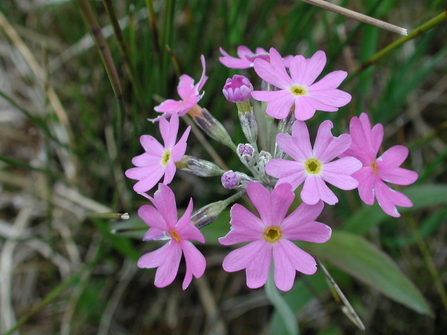
Primula farinosa flower heads. Credit: Christoph Moning via iNaturalist.
Alpine bartsia (Bartsia alpina)
NVC habitat types: M10
Alpine bartsia is a small herb of around 20 cm in height. It has a dark purple hue, and all parts of the plant are covered in fine down. It was first identified in Westmorland in 1668 by the renowned naturalist John Ray who authored the groundbreaking Historia Plantarum, a work which laid the foundation of contemporary botany. It bears some resemblance to members of the figwort family (Scrophulariaceae) and indeed it was formerly classified in this family. Currently however, the species is now classified in the Orobanchaceae family alongside the broomrapes, eyebrights and cow wheats, with which it shares parasitic traits. Unlike broomrapes however, Alpine bartsia is hemi-parasitic rather than wholly parasitic (it still retains chlorophyll in the leaves unlike the former). Its parasitic nature highlights the challenges of growing in a waterlogged habitat, and the adaptations which plants develop to gain nutrients. It is a root parasite on several plants including common butterwort and Scottish asphodel. Presence of a known host species does not necessarily mean that it is actively parasitising as root parasites are able to complete their lifecycle independently. The flowers of the species are protogynous meaning that they begin life as female before changing to male, with the stigma no longer receptive when the pollen is shed to prevent self-pollination.
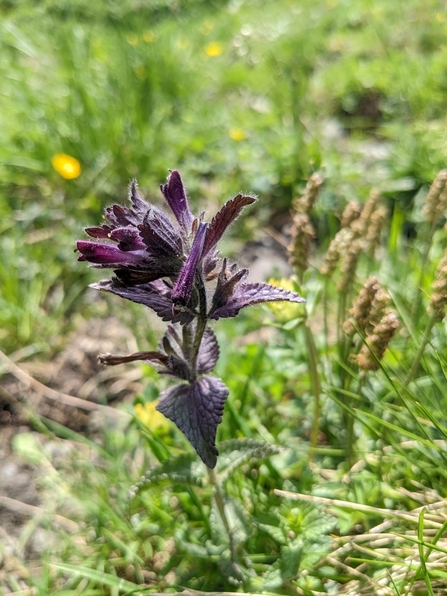
Bartsia alpina in flower. Credit: Todd Boland via iNaturalist.
In the UK Alpine bartsia is very rare and restricted to a just a handful of locations in the uplands of central Scotland and the north of England. Populations in England number only a handful of individuals whereas in Scotland although localised, stem counts can number in the thousands. The habitat in which it is found varies by location. In England it is more strictly a mire species favouring calcareous flushes and marsh areas of the same type as birds eye primrose; indeed, on occasion the two species occur together. In Scotland however, it occurs only on base-rich wet ledges and in damp meadows.
The range of the species is contracting in the UK, thought to be the result of over-grazing, trampling and drainage. Research from Widdybank pasture in Upper Teesdale in the North Pennines has highlighted that while some grazing is important in keeping an open sward, heavy grazing from cattle results in declines.
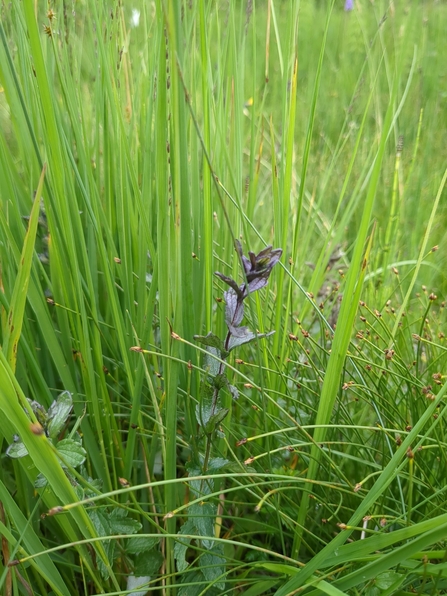
Bartsia alpina growing in amongst grass and sedge sward, showing the challenge of finding these small plants. Credit: N. Resar via iNaturalist.
Scorched Alpine-sedge (Carex atrofusca)
NVC habitat types: M11
A rare and beautiful arctic-alpine sedge, currently found on just 5 UK sites, all of which are highly restricted alpine pioneer formation habitats, a type of alkaline fen occurring only at high altitude. The species was formerly recorded at lower altitudes (below 600 m). However, as with many alpine species facing the pressure of the changing climate, the species range has moved increasingly upwards, and it is now found only between 680 – 1000 m. Outside of the UK it is found predominantly in Fennoscandia with a few localities in the Alps.
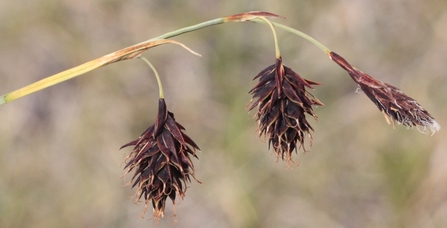
Scorched Alpine Sedge. Credit: Torre Jorgensen.
Carex atrofusca is similar in appearance to Carex atrata (Black Alpine-sedge) but the latter is a species of calcareous ledges meaning that the habitat difference is a useful identifier. The species has a large root system, which helps the plant to stay secure under the extreme weather conditions that it is exposed to. The spreading roots also mean that it plays an important role in helping to prevent erosion by binding the soil or peat on which it is growing. This makes it an important pioneer species. It also acts a food source for birds including ptarmigan. Although rare, the changes in distribution of the species and others in high altitude zones means that these plants are important in understanding overall ecosystem health in these extreme environments. They can help to understand changes in hydrology, soil conditions and climate.
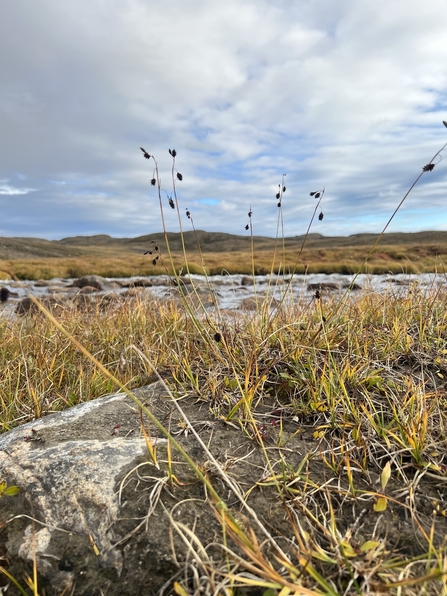
Carex atrofusca growing in situ showing the typical growth form. Credit: Jamie Fenneman via iNaturalist.
Marsh saxifrage (Saxifraga hirculus)
NVC habitat types: M10, M38
Marsh saxifrage, in common with other the other species that we have discussed here, is a small species, growing to a maximum of around 20 cm. It is an erect herb which has both basal leaves and leaves which grow up the stem. Typically, each stem has just one flower, although two or three are occasionally recorded. They are pollinated by a variety of invertebrate species, but hoverflies are their most common pollinator. It prefers the marginal transition habitats between bog and fen where the substrate is neutral or weakly acidic, receiving some base enrichment from continual, if weak, water flow. As well as the striking yellow flowers, the other distinctive feature of the species is the presence of short rather straggly red hairs scattered along the flowering stem.
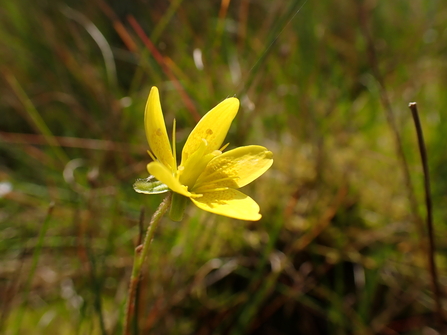
Close-up of the flowering head of Saxifraga hirculus. Credit: Skjold Søndergaard via iNaturalist.
The most significant threat to the species has been the drainage that occurred during the post war period. However, the BSBI found that the blocking of such drains had the potential to negatively impact populations, because this tended to result in more static ponding of the water supply rather than the slow percolation favoured by the species. Livestock preferentially graze the flowering stems, and while exclosures have been used in some areas to reduce this impact this has led to overgrowth by more competitive species, thereby highlighting the difficulties facing conservation planning for the species. The flowering capability is also affected by water chemistry which may explain why alterations to the habitat can lead to unpredictable outcomes.

Saxifraga hirculus growing in Greenland alongside Dryas octopetala, highlighting the adaptability of these plants to a range of growing conditions. Credit: Eero Koskinen via iNaturalist.
Marsh saxifrage was formerly also found in more southerly and lower altitude sites, but devastating loss of peatland ecosystems from the UK’s lowlands fen regions means that the species is now extinct in these areas. The BSBI states that the species was once widespread from Cheshire to Caithness. Due to the contraction of its range from lowland regions since the 19th century however, it is now found only in upland habitats. This highlights the importance of conservation of the remote upland habitats where the species still occurs and demonstrates how these areas act as refugia for species. Although the species is rare, in some locations the number of individuals can number in the hundreds of thousands. 90% of the UK population occurs in the North Pennines, specifically Upper Teesdale, Cross Fell and the Appleby fells. Much of the Scottish population has been lost apart from a few scattered locations, the most significant of lies amidst the Pentland hills.
Selected reading
Foss_&_Crushell_2007_Fen_report.pdf
JNCC distribution maps Calcium-rich springwater-fed fens (Alkaline fens) - Special Areas of Conservation
Factfile 5: Fens and Flushes | Title
Definition of FCS for alkaline fen for England Definition of Favourable Conservation Status for alkaline fens - RP2985
#61 Bird's-eye Primrose by Elizabeth Sullivan — neyedc
Primula farinosa L. in BSBI Online Plant Atlas 2020, eds P.A. Stroh, T. A. Humphrey, R.J. Burkmar, O.L. Pescott, D.B. Roy, & K.J. Walker. https://plantatlas2020.org/atlas/2cd4p9h.94n [Accessed 01/05/2025]
Tofieldia pusilla (Michx.) Pers. in BSBI Online Plant Atlas 2020, eds P.A. Stroh, T. A. Humphrey, R.J. Burkmar, O.L. Pescott, D.B. Roy, & K.J. Walker. https://plantatlas2020.org/atlas/2cd4p9h.24c [Accessed 01/05/2025]
Bartsia alpina L. in BSBI Online Plant Atlas 2020, eds P.A. Stroh, T. A. Humphrey, R.J. Burkmar, O.L. Pescott, D.B. Roy, & K.J. Walker. https://plantatlas2020.org/atlas/2cd4p9h.4pm [Accessed 01/05/2025]
Carex atrofusca Schkuhr in BSBI Online Plant Atlas 2020, eds P.A. Stroh, T. A. Humphrey, R.J. Burkmar, O.L. Pescott, D.B. Roy, & K.J. Walker. https://plantatlas2020.org/atlas/2cd4p9h.yfc [Accessed 01/05/2025]
Saxifraga hirculus L. in BSBI Online Plant Atlas 2020, eds P.A. Stroh, T. A. Humphrey, R.J. Burkmar, O.L. Pescott, D.B. Roy, & K.J. Walker. https://plantatlas2020.org/atlas/2cd4p9h.w14 [Accessed 01/05/2025]
Marsh saxifrage (Saxifraga hirculus) - Special Areas of Conservation
Hedley, S. & Walker, K.J. 2015. Saxifraga hirculus L. Marsh Saxifrage. Species Account. Botanical Society of Britain and Ireland Saxifraga_hirculus_species_account.pdf

